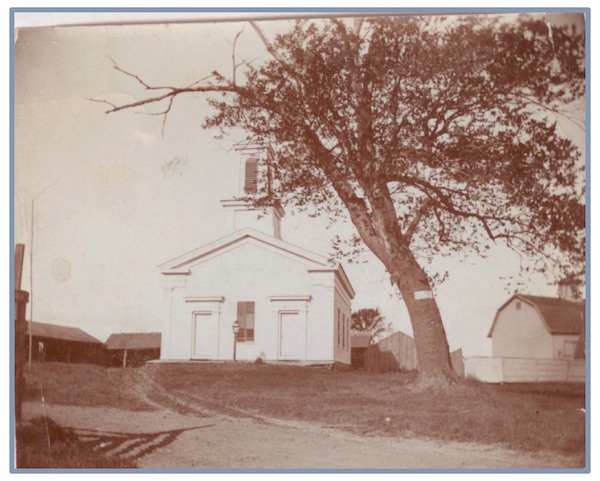Illuminating Orleans – The Ballou Diaries, Part 4 (1853-55)

Located at the intersection of Oak Orchard River Road and Route 18, the Carlton Presbyterian Church was torn down in 1960-61.
By Catherine Cooper, Orleans County Historian
Illuminating Orleans – Vol. 2, No. 9
“Thursday, October 27, 1854. Warm and pleasant. The Presbyterian Church was dedicated today.” – Sarah Ballou
“February 16, 1853. Snows and thaws most of the day. Elder Mudge had a donation last night, got over 100 dollars.” – Sarah Ballou

At that time, it was customary for a congregation to hold a donation party for the pastor once a year to raise funds for his living expenses.
Sarah Ballou continued to record diary entries about farm life on the Oak Orchard River Road in Carlton for the years 1853-55. Though brief, they combine to convey a wealth of information.
The annual cycle of farm work continued for Hosea and Sarah. He chopped wood, plowed, threshed oats, harvested wheat and corn, despite being unwell in 1853, afflicted by some unnamed lingering ailment. There are many references to his ill health, but there is no reference to a specific illness, or even any emotion, though it must have been worrisome for them since their livelihood was dependent on his ability to work.
His troubles began in February, 1853. He bought a new sleigh on Jan. 28, but was “most sick” on Feb. 2, a little better on Feb. 3. “Not very well, a pain in his stomach” in April and sick again in July. Both of them were sick in September, and even had assistance with chores.
Sept. 8: Cool. Belinda came and washed for me. Frank doing the work here, plowing. Both of us sick.
Sept. 13: Pleasant. Helen came here this morning. Hosea don’t [sic] get much better.
Sept. 27-30: Hosea has chills.
Oct. 27-30: Hosea is quite sick.
Oct. 24: He is sick tonight. He finally went to see a Dr., but there is no reference to a diagnosis. There are no subsequent references to his ill health.
Hosea “carried some turnips to the Dr.” in December, perhaps as a partial payment for his care.
Their farm operation was small but varied. Sarah used the diary to record sales. They regularly sold butter (14 to 19 cents per pound) and eggs (9 to10 cents per dozen) at the store. Additional sales included:
• 150 bushels of wheat for $2 a bushel
• 88 ½ lbs wool, for 35 cents a lb.
• Sold wheat for $254
• 332 lbs pork for $5.25 a hundred
• Steers for $55
• 15 sheep for 20 / a head. (The / sign indicated a shilling, 12 ½ cents)
Sarah continued her sewing business and used the diary to record the garments she made for her clients. She purchased several items in Albion for her own wardrobe: a blue silk bonnet, gave 3 dollars for it, a cashmere dress, 3 / a yard, a delaine dress, shoes, got 3 yds. silk for a cape & got a pair of mitts, gave 4 /.
An entry in Sept. 1854 mentioned that: “Hosea went to Mr. Gates to pay him all he owed on the land $100.40.”
As soon as he owned the land, Hosea started to make improvements. He had a well installed in Oct. 1854 by a Mr. Hubbard and his team of workers. The cost was $40, Hosea built the platform around it.
He started building a house the following year.
June 4: Cold. Hosea commenced drawing hemlock lumber for a new house, from the lake. Got it of John Pratt. Gave $7 a 1000.
Sarah noted the following costs associated with the construction: Sand from Elias Williams, 7 loads, 2 / a load. Lime from Barre, 32 bushels, 14 cents a bushel. Shingles from Albion, 17 bunches, $23
He also got pine lumber from the lake, the cost was not indicated. George Beardsley, Levi Lawrence and a Mr. Ostrander worked on the house, Hosea helped when he was not doing farm work.
Unfortunately, the last diary entry is from October 30, 1855, they were still working on framing.
There are some intriguing references in the diary entries for this period. Hosea bought a “balm in gilead tree,” a balsam poplar also called black cottonwood.
In April 1854, he got a ton of plaster from Knowlesville and “sowed plaster” the following day. The “plaster” was gypsum, which was used as a fertilizer, being a source of calcium and sulfur.
A good deal of the Ballou’s activities were centered on The Bridges. They attended exhibitions at the schoolhouse. In October 1853, Hosea attended a political meeting at The Bridges, L.M. Burrows the speaker. He went to hear a Dr. Knapp from Lockport speak in October, 1854. According to an article by Jim Boles of the Museum of disABILITY, Dr. Knapp promoted hydropathy, also known as the Water-Cure Treatment, which purported to cure pains, insomnia, mental disorders, addiction and arthritis.
We leave Hosea and Sarah in 1855, having had a five-year glimpse into their world. They had a new house, a well, cows, sheep, horses, chickens and hogs. They produced their own butter, eggs meat. Gooseberry bushes and melons added variety to their garden. Peonies, rose bushes and poplars enhanced the property. They had relatives nearby and a robust social circle.
But the winds of war had begun to roil.
On November 18, 1854, Hosea and Sarah went to hear a fugitive slave lecture.
The following year, on August 18, 1855: “We went to The Bridges in the afternoon to hear Fred Duglass [sic] lecture on slavery.”





































































